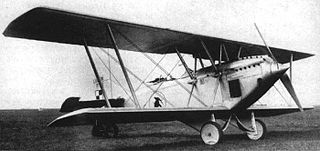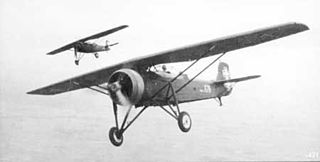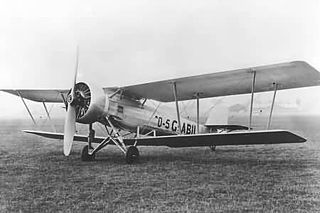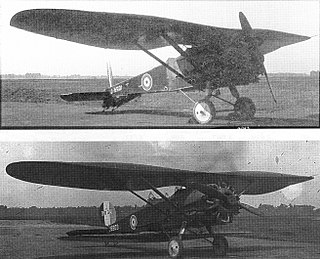
The Hawker Harrier was an experimental biplane torpedo bomber aircraft built by Hawker Aircraft to a specification issued in the 1920s for the RAF.

The PZL.23 Karaś was a Polish light bomber and reconnaissance aircraft designed in the early 1930s by PZL in Warsaw.

The Lublin R-VIII was a Polish bomber, reconnaissance aircraft and seaplane designed in the late 1920s by the Plage i Laśkiewicz factory in Lublin. It was the first in-house design of Plage i Laśkiewicz, and the first with the name Lublin.

The ANBO IV was a reconnaissance aircraft used by the Lithuanian Air Force in World War II, designed by Lithuanian aircraft designer Antanas Gustaitis. The Lithuanian ANBO 41 was far ahead of the most modern foreign reconnaissance aircraft of that time in structural features, and most importantly in speed and in rise time. All ANBO 41 aircraft were likely destroyed during World War II.

The Fairey Hendon was a British monoplane, heavy bomber of the Royal Air Force, designed by Fairey Aviation in the late 1920s. The aircraft served in small numbers with one squadron of the RAF between 1936 and 1939. It was the first all-metal low-wing monoplane to enter service with the RAF.

The PZL P.6 was a Polish fighter, designed by the engineer Zygmunt Puławski, manufactured by PZL state-owned factory. It remained a prototype and did not go into production.

The Breda Ba.64 was an Italian single-engine ground-attack aircraft used by the Regia Aeronautica during the 1930s.

The ANBO I was a single-seat aircraft developed in Lithuania, proposed as a trainer for the Army It was a low-wing, braced monoplane of conventional tailwheel configuration. The fuselage structure was of fabric-covered welded steel tube, The wing had a wooden, two-spar structure and was fabric covered but the fuselage, also fabric covered, had a welded steel tube structure.
The Lublin R-XX was the Polish torpedo bomber floatplane, designed in the early 1930s in the Plage i Laśkiewicz factory in Lublin. It remained a prototype.

The Vickers Vespa was a British army cooperation biplane designed and built by Vickers Limited in the 1920s. While not adopted by Britain's Royal Air Force, small numbers were bought by the Irish Free State and Bolivia, the latter of which used the type during the Chaco War. One modified Vespa was used to set a world altitude record of 43,976 ft (13,407 m) in September 1932.

The Bristol Bullfinch was an experimental British military aircraft first flown in 1922. Variants were built as both parasol wing monoplanes and biplanes, but both versions proved unsuccessful, and only the three prototypes were built.
The Piaggio P.32 was an Italian medium bomber of the late 1930s, produced by Piaggio, and designed by Giovanni Pegna. It was a modern design for its time, but was a failure due to lack of powerplants commensurate with its high wing loading.

The Heinkel HE 5, produced in Sweden as the Svenska S 5 and nicknamed the "Hansa", was a reconnaissance floatplane built during the 1920s. It was a further development of the HE 1, sharing its same basic configuration as a low-wing, strut-braced monoplane. The HE designation also refers to the monoplane construction, standing for Heinkel Eindecker.

The Savoia-Marchetti S.72 was an Italian three-engine transport monoplane designed and built by Savoia-Marchetti as an enlarged and strengthened version of the earlier S.71. The S.72 was a three-engine, high-wing cantilever monoplane with a fixed tailwheel landing gear. Designed as a heavy bomber, the prototype was first flown in 1934 powered by three 410 kW (550 hp) Alfa Romeo licence-built Bristol Pegasus radial engines.

The Mitsubishi Army Type 92 Reconnaissance Aircraft (九二式偵察機) was a Japanese short-range reconnaissance aircraft of the 1930s designed by Mitsubishi for the Imperial Japanese Army Air Force. A total of 230 were built, serving between 1933 and 1936. A parasol monoplane, the Type 92 was the first military aircraft powered by an engine both designed and manufactured in Japan to enter service.

The Gloster Goring was a single-engined two-seat biplane designed to meet 1926 Air Ministry specifications for a day/torpedo bomber. It was not put into production and the one aircraft built served later as an engine testbed.

The Vickers Type 253 was a single-engined two-seat biplane general-purpose military machine built to a 1930 government specification. It won a production contract, but this was transferred to the same company's monoplane equivalent, the Wellesley. Only one Type 253 was built.

The Loire 250 was a French single-seat fighter monoplane designed and built by Loire Aviation of St. Nazaire.
The Breda Ba.46 was a three-engined Italian bomber transport, developed from a similar but lower-powered civil transport. It was designed in Italy in the mid-1930s for colonial policing but not put into production.

The NVI F.K.35 or Koolhoven F.K.35 was a two-seat fighter aircraft built in the Netherlands during 1926. It was completed and exhibited but, through a combination of ground accident and financial problems, never flown.

















